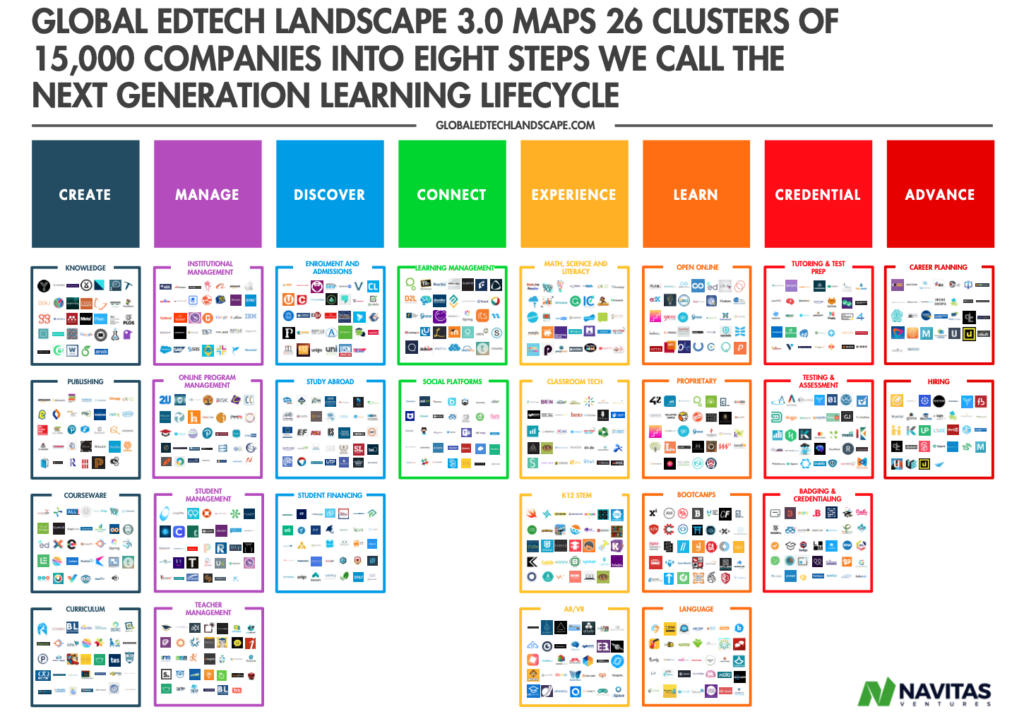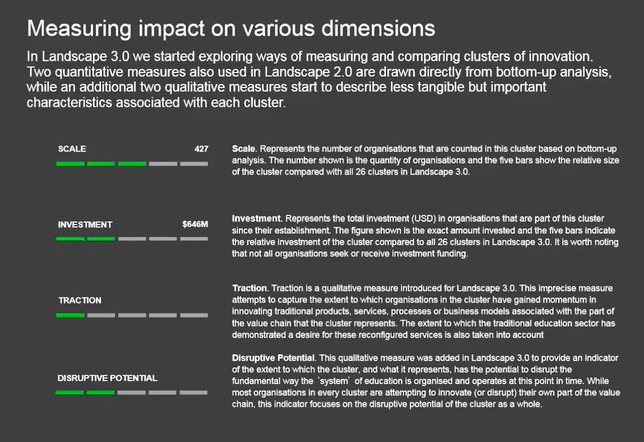Can we trust EdTech sector to determine what’s wrong with our educational systems?
In week 2 of the Critical Issues in Digital Education course, we were encouraged to reflect on whether the EdTech sector offers a valid diagnosis of what’s wrong with education and whether it can therefore offer valid solutions. After reflecting on the resources provided, I would like to take it even further and question whether we can even trust any company in the EdTech sector to determine what is wrong with our educational systems. In the following post, I would like to argue that based on how the success of the companies in this sector is measured, we cannot and we should therefore always approach any educational analysis offered by these companies with a degree of skepticism and criticism.
One of the resources we were offered to analyze this week was the Navitas Global EdTech Landscape 3.0 which categorizes 15,000 EdTech companies into 26 clusters that are further categorized into eight steps of the “learner journey”.

Navitas EdTech landscape 3.0. Source: https://navitasventures.com/insights/landscape/
Navitas is an Australian-owned for-profit private education services company that defines itself as a “global education provider that connects students, agents, universities, and industry to an exceptional international higher education experience”. It is the largest private non-university higher education provider in Australia, which has put it at the center of discussion about the role of such for-profit higher education providers and how their for-profit model might be compromising the quality of education in favor of financial profit (Shah & Sid Nair, 2013). When introducing the report, Navitas representatives do not shy away from being upfront about the goal of the report being a guide for potential investors that would help them navigate the EdTech sector, with the ultimate goal one would assume to attract more investors to Navitas itself.
When analyzing the report, it is interesting to consider how the companies presented here were measured against each other and prioritized in the report. Four criteria determine the “impact” according to the report:
- Scale (number of companies in each cluster)
- Investment (total investment dollar value) – in their webinar presenting the report, the company acknowledges this is often the most important criterion for an individual company.
- Traction (a qualitative measure of the extent to which the cluster has been adopted by the general audience, including the traditional education sector)
- Disruptive potential (a qualitative measure of the extent to which the cluster has the potential to disrupt the “system” of education at this point in time) – this particular criterion raises the most questions from my side that I could find no answers for (which “system” exactly? according to whom?)
Whether the four criteria are weighted equally is not clear.

Criteria of impact measurement of various EdTech dimensions based on which the Navitas Global EdTech Landscape 3.0 is built. Source: https://learningandteaching-navitas.com/events/edtech-sector-landscape-3/
Moving away from the Navitas report and its criteria, I do believe private for-profit companies can be successful in offering solutions to many educational challenges. However, I find it problematic when they are the only ones defining what those problems are without having a meaningful dialogue with public sector universities and other democratic institutions.
To sum up, while I don’t believe it is wise to completely dismiss all EdTech companies as inadequate and claim that public education is the only game in town, I don’t think we can genuinely rely on EdTech to help us decide what is right or wrong with our educational systems. While success in this sector is strictly measured against capitalist criteria such as scale and investment dollars, players that are competing against these criteria at best can be focused on the qualification function of education (see my week 1 post) which is seen as important by private investors. Therefore, if we believe that successful participation in the capitalist model is not the only function of education, we cannot fully entrust private for-profit companies to be the only decision-makers determining what is right or wrong with our educational systems. We should aim to have more diverse voices in determining what success or failure of education looks like not solely based (and rewarded by) financial profit and investment dollars.
References
- Navitas Global EdTech Landscape 3.0: https://navitasventures.com/insights/landscape (last consulted on January 28, 2024)
- Shah, M. & Sid Nair, C. (2013) Private for-profit higher education in Australia: widening access, participation and opportunities for public-private collaboration, Higher Education Research & Development, 32:5, 820-832, DOI: 10.1080/07294360.2013.777030




Hi there, Marta!
Thanks for this blog post. It is exciting to see that you’re developing your own stance towards digital education.
I want to begin my feedback by signalling that you stated clearly your argument in the introductory paragraph of your blog:
“I would like to argue that based on how the success of the companies in this sector is measured, we cannot and we should therefore always approach any educational analysis offered by these companies with a degree of skepticism and criticism.”
I also would like to highlight that you develop your argument by analysing Navita’s discourse on company success. You are doing a great job here by structuring your writing around a clear argument.
You are also doing a great job using images and hyperlinks. Maybe you can explore using headers or embedded videos in your next blog post.
You can improve your future blog posts by following these three recommendations.
First, I can see that you stated your own question in the introduction of your text. Nonetheless, it is important that you answer each week’s question. You could also add another related question, but you would have to answer both in your writing. This week’s question is particularly important, as it invites you to think about the gaps/problems in your educational system (or through your educational experiences) and how digital education is positioned (or frames) said problems.
Second, it is important that you tap into each week’s readings. Week 2 readings were about how companies diagnose the educational system’s problems. In the tech industry, this diagnosis involves promoting some sort of tech as the solution – think about the current hype of AI. How do these readings speak to your experience?
Finally, you can develop your argument by tapping into your own context/experience. As someone who works in the field of instructional design, what is your experience in framing educational problems? Or reflecting on your life as a past/current student, what are the problems of educational systems? Are they the same ones that edtech companies propose?
Hi Nicolas,
Thank you so much for your feedback.
It was indeed helpful to formulate my argument clearly in the first paragraph. I will continue to do so. I also agree with the two things that could be improved: not diverging too much from the original question and drawing on my experience.
Particularly in this week’s post, reflecting on my experience working with various EdTech vendors and the problems with education they claim to solve could have added more context. We have discussed it in the turorial, but I should also remember to include that in my posts.
To add to my post on the problems EdTech companies often claim currect educational systems have include:
– “bloated” curriculum.
– being too far removed from job market needs.
– inflexible testing and exams.
– teachers who are overwhelmed with administrative tasks and don’t have creative freedom.
I look forward to reflecting on some of these claims in my next posts.